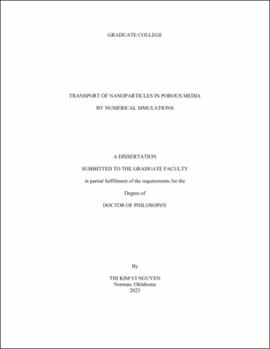| dc.description.abstract | This thesis focuses on three primary topics related to the movement of fluid and nanoparticles (NPs) in porous media. While prediction of local fluid velocities within porous media are significant, conducting experiments to measure them can be exceedingly difficult. Therefore, this work aimed to develop methods to predict velocity distributions in porous media. The lattice Boltzmann method was applied to solve for the fluid velocity fields through different media, such as sphere packings, scaffolds, sandstones, carbonates, and synthetic silica. The one-sample Kolmogorov-Smirnov (KS) goodness-of-fit statistical tests were utilized to examine whether the velocity distributions in different porous media followed any known distribution types, whereas the two-sample KS goodness-of-fit tests were used to determine if the velocity and pore-size distributions are statistically similar. Simulation results indicated that the velocity magnitude and pore volume in a porous medium follow the same distribution for all the examined porous media with continuous pore size distributions. In addition, velocity magnitude distributions in scaffolds and sphere packings with random configurations could be predicted by a single Weibull distribution model within statistical accuracy.
The hydrodynamic dispersivity of nanoparticles (NPs) is a significant parameter in determining their mobility, and our study sought to investigate this parameter using the Lagrangian approach, as opposed to the Eulerian approach that has been commonly employed in previous studies. The lattice Boltzmann method (LBM) was employed to simulate flow in porous media, and Lagrangian particle tracking (LPT) was used to track the movement of individual dispersing particles without considering the particle-particle interactions. In other words, the movement of particles was a consequence of both the molecular diffusion of the particles themselves and the convection of the surrounding fluid. It was found that the hydrodynamic dispersion coefficient linearly depended on the effective Lagrangian Peclet number, based on a length scale that took the molecular diffusion effects as well as the convection effects into account; and this relationship held for different porous media. More importantly, this linear equation was simpler and more precise than the one formed by using the Eulerian Peclet number with a fixed length scale. This result confirmed that Lagrangian length and time scales were appropriate for modeling particle dispersion.
The mobility of NPs in porous media is significantly impacted by their tendency to aggregate since large aggregates may induce some problems such as pore clogging or blocking and reduce the mobility of NPs. Thus, a new model, Lagrangian Particle Tracking based on the force balance approach (LPT/FB), was built to simulate the aggregation process and to predict the morphology of aggregates when particles move in porous media. It relied on Newton’s second law of motion and took interaction forces among particles into account. Aggregation kinetics and fractal dimension results from the computational model for Cerium oxide (CeO2) particles, suspended in potassium chloride (KCl) solutions with different concentrations, were verified against experimental results. The model was then employed to investigate the effects of ionic strength, pore velocity, and particle size on the aggregation of CeO2 particles together with their fractal dimension and asphericity when they moved in randomly packed spheres. The electrolyte concentration was found to be the most important factor impacting the aggregation process and the aggregate structure. It was followed by the pore velocity, which considerably influenced the aggregation kinetics and fractal dimensions, especially in the diffusion-limited regime. The primary particle size had a minor effect on the aggregation kinetics but created a noticeable change in the fractal dimension of reaction-limited aggregates. | en_US |
